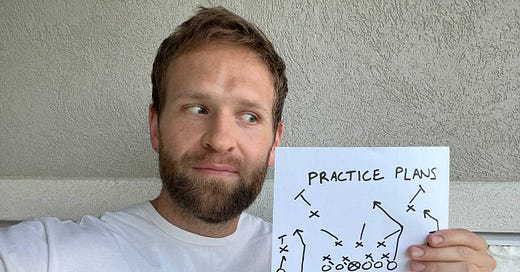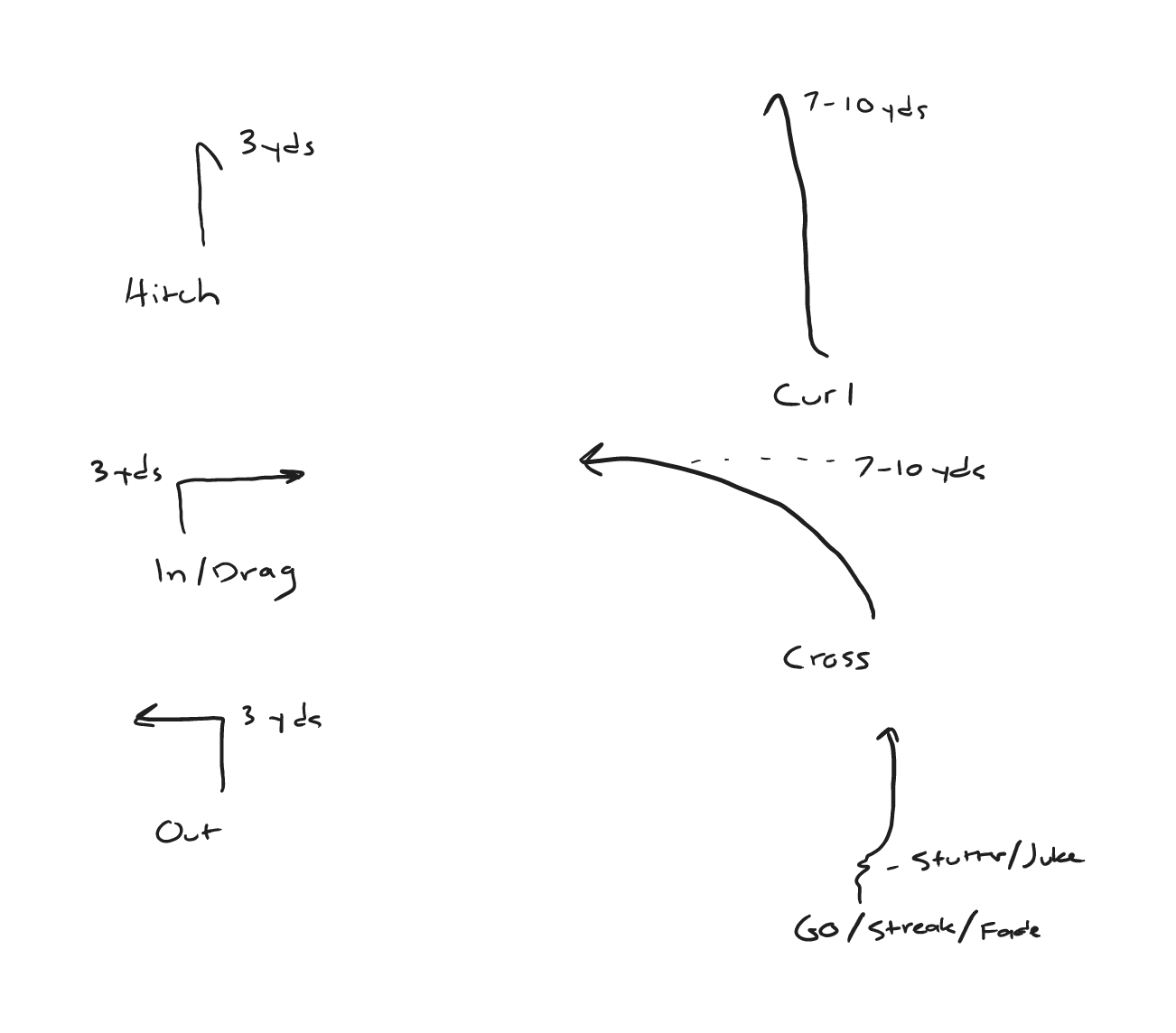Flag Football - Practice Plan
For this post, I write about setting up a practice plan and the drills I run to get the most out of practice. Kindergarten - 6th, the main principles apply, but the sophistication grows with each age.
Creating a Practice Plan
With each season - you have to have a baseline of fundamentals. This allows you to build and progress throughout the season. Here are the three main objectives I hit in each practice:
Conditioning - Football specific moves and drills
Offensive skills and strategy
Defensive skills and strategy
Understand Your Age Group
The attention span of kids will differ from kindergarten through sixth grade. It’s important to teach them something every practice, but start slow and also understand the age of your team so you can mix in some games to bring their attention back.
Conditioning
I’m coaching first graders this year. For conditioning, I run them through a circuit that works on endurance, foot speed, agility and a whole body workout. Football is a sprint and rest type sport - so your kids need to have the endurance and strength to get through each play running full speed to be effective.
Here’s is the exact agility course that I put my team through each practice. It’s a mix of different drills that focus on different football aspects to condition their body and minds for football.
Offensive Skills and Strategy
Start with the basics. Offense is the more challenging scheme because it requires organization and timing. Defense is more reactionary, so the offensive side requires more reps to run properly.
These are the drills that I love the most for this age that can be used in each grade:
Route Running
1 on 1’s
Offense vs air
Route Running
Keep it basic. I have six different routes that I install that are easy to remember and execute. I typically have two lines and we go through the entire route tree, calling out the name and having the kids run it and switch sides each time usually 4 reps for each route.
As the season progresses, I spend less time with this drill and put more time into scrimmage time.
Here’s an example of the different routes I use throughout the year:
1 on 1’s
After routes, we move to 1 on 1’s. This helps bring some intensity and competition to practice, building their skills by trying to beat someone. I’ll have a coach throw and then mix in time with the QB of the team to get continuity with the receivers.
The only rule is they have to choose one of the routes we worked on and then beat their man. (Great for both offense and defense, more on defense below)
Offense vs Air
Once we get the more individual skill drills completed, I have two offensive units running through all the main plays that I’ve put in to rep as many as I can in 20 minutes, back to back.
This helps kids get familiar with the play calling and combining the action of running the play.
*For an example play book that I’ve created, download it here
Defensive Skills and Strategy
Defense is a little easier to implement at the grade school level because it’s reaction based. You need to rep it, but the scheme is easier to grasp and it’s primarily about getting lined up, angles, and pursuit.
Here are the drills I love the most for the defensive side:
1 on 1’s pursuit drill
1 on 1’s vs offense
Circle flag drill
Scrimmage
1 on 1’s Pursuit Drill
This is actually great for both offense and defense. It helps the ball carrier understand the different cut points to look for, and defensively it helps the kids take an inside out angle to get in front and make a play.
Ball carrier chooses a side and runs full speed, can cut up any time they want.
For defense, you can either practice getting in front of the ball carrier and forcing them back to the middle or trail a half step behind and chasing them to the boundary.
Here’s a look at how the drill is set up:
1 on 1’s vs Offense
We covered this one already on the offensive side. For defense, I focus on alignment, running with their man, and then making a play on the ball.
A little more advanced, you can switch between zone and man, just make sure your routes matchup with whatever the call is so they can compete. (Can’t call a crossing route on zone in 1 on 1’s)
Defensively, at the 1st - 2nd grade level, zone works great. I coach everyone to play their area, find the ball and then pursue to get in front of the runner to at least slow them down to make a play.
Here’s my standard defense for 1st grade - as they get older, they’ll be able to handle shifts and other types of blitzes.
Circle Flag Drill
This is a fun drill to keep all their attention. I make a big circle out of the cones, then have 2-3 ball carriers. The defense has 15 seconds to pull all the flags, whoever loses has to do pushups.
I run this drill multiple times to get a lot of reps for pulling flags and it’s fun to keep them engaged.
Scrimmages
Once you have the basics, scrimmages are one of the best things to get them prepared for the games. Especially when you start to install new plays on top of your base offense. Get the reps in practice to make sure the timing and spacing is solid for the game.
I always make sure we have more of the offense playing because it requires more precision and the defense can still get solid reps with lower numbers.
I run 10 plays while moving the ball and then switch. These scrimmages are usually the last thing that we do for practice, so I run as many plays as I can get. It’s very high tempo and rep heavy to get them ready for the game. The more plays we can run, the better for the team and the games.
I hope you all enjoyed this post. If you did, please share with others who might find it valuable. And please leave comments and questions, would love to connect with you throughout your season.
Good luck - catch you on the next one!








